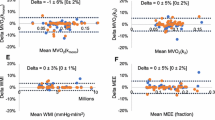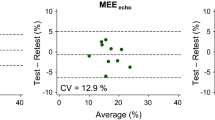Abstract
Background
Cardiac metabolic changes in heart disease precede overt contractile dysfunction. However, metabolism and function are not typically assessed together in clinical practice. The purpose of this study was to develop a cardiac positron emission tomography/magnetic resonance (PET/MR) stress test to assess the dynamic relationship between contractile function and metabolism in a preclinical model.
Methods
Following an overnight fast, healthy pigs (45-50 kg) were anesthetized and mechanically ventilated. 18F-fluorodeoxyglucose (18F-FDG) solution was administered intravenously at a constant rate of 0.01 mL/s for 60 minutes. A cardiac PET/MR stress test was performed using normoxic gas (FIO2 = .209) and hypoxic gas (FIO2 = .12). Simultaneous cardiac imaging was performed on an integrated 3T PET/MR scanner.
Results
Hypoxic stress induced a significant increase in heart rate, cardiac output, left ventricular (LV) ejection fraction (EF), and peak torsion. There was a significant decline in arterial SpO2, LV end-diastolic and end-systolic volumes in hypoxia. Increased LV systolic function was coupled with an increase in myocardial FDG uptake (Ki) during hypoxic stress.
Conclusion
PET/MR with continuous FDG infusion captures dynamic changes in both cardiac metabolism and contractile function. This technique warrants evaluation in human cardiac disease for assessment of subtle functional and metabolic abnormalities.







Similar content being viewed by others
Abbreviations
- LV:
-
Left ventricle
- RV:
-
Right ventricle
- EF:
-
Ejection fraction
- EDV:
-
End-diastolic volume
- ESV:
-
End-systolic volume
- 18F-FDG:
-
18F-fluorodeoxyglucose
- TAC:
-
Time-activity curve
References
Bache RJ, Zhang J, Murakami Y, Zhang Y, Cho YK, Merkle H, et al. Myocardial oxygenation at high workstates in hearts with left ventricular hypertrophy. Cardiovasc Res. 1999;42:616-26.
Chess DJ, Lei B, Hoit BD, Azimzadeh AM, Stanley WC. Effects of a high saturated fat diet on cardiac hypertrophy and dysfunction in response to pressure overload. J Cardiac Fail. 2008;14:82-8.
de las Fuentes L, Soto PF, Cupps BP, Pasque MK, Herrero P, Gropler RJ, et al. Hypertensive left ventricular hypertrophy is associated with abnormal myocardial fatty acid metabolism and myocardial efficiency. J Nucl Cardiol. 2006;13:369-77.
Doenst T, Pytel G, Schrepper A, Amorim P, Färber G, Shingu Y, et al. Decreased rates of substrate oxidation ex vivo predict the onset of heart failure and contractile dysfunction in rats with pressure overload. Cardiovasc Res. 2010;86:461-70.
Fu Y, Xiao H, Ma X, Jiang S, Xu M, Zhang Y. Metformin attenuates pressure overload-induced cardiac hypertrophy via AMPK activation. Acta Pharmacol Sin. 2011;32:879-87.
Kundu BK, Zhong M, Sen S, Davogustto G, Keller SR, Taegtmeyer H. Remodeling of glucose metabolism precedes pressure overload-induced left ventricular hypertrophy: Review of a hypothesis. Cardiology. 2015;130:211-20.
Sen S, Kundu BK, Wu HC-J, Hashmi SS, Guthrie P, Locke LW, et al. Glucose regulation of load-induced mTOR signaling and ER stress in mammalian heart. J Am Heart Assoc. 2013;2:e004796.
Zhabyeyev P, Gandhi M, Mori J, Basu R, Kassiri Z, Clanachan A, et al. Pressure-overload-induced heart failure induces a selective reduction in glucose oxidation at physiological afterload. Cardiovasc Res. 2013;97:676-85.
Zhong M, Alonso CE, Taegtmeyer H, Kundu BK. Quantitative PET imaging detects early metabolic remodeling in a mouse model of pressure-overload left ventricular hypertrophy in vivo. J Nucl Med. 2013;54:609-15.
Yang T, Wang L, Xiong C-M, He J-G, Zhang Y, Gu Q, et al. The ratio of (18)F-FDG activity uptake between the right and left ventricle in patients with pulmonary hypertension correlates with the right ventricular function. Clin Nucl Med. 2014;39:426-30.
Taylor M, Wallhaus TR, Degrado TR, Russell DC, Stanko P, Nickles RJ, et al. An evaluation of myocardial fatty acid and glucose uptake using PET with [18F]fluoro-6-thia-heptadecanoic acid and [18F]FDG in patients with congestive heart failure. J Nucl Med. 2001;42:55-62.
Villien M, Wey H-Y, Mandeville JB, Catana C, Polimeni JR, Sander CY, et al. Dynamic functional imaging of brain glucose utilization using fPET-FDG. NeuroImage. 2014;100:192-9.
Brooks RA, Di Chiro G, Zukerberg BW, Bairamian D, Larson SM. Test-retest studies of cerebral glucose metabolism using fluorine-18 deoxyglucose: validation of method. J Nucl Med. 1987;28:53-9.
Schmidt ME, Ernst M, Matochik JA, Maisog JM, Pan BS, Zametkin AJ, et al. Cerebral glucose metabolism during pharmacologic studies: test-retest under placebo conditions. J Nucl Med. 1996;37:1142-9.
Hahn A, Gryglewski G, Nics L, Hienert M, Rischka L, Vraka C, et al. Quantification of task-specific glucose metabolism with constant infusion of 18F-FDG. J Nucl Med. 2016;57:1933-40.
Boos CJ, Mellor A, O’Hara JP, Tsakirides C, Woods DR. The effects of sex on cardiopulmonary responses to acute normobaric hypoxia. High Alt Med Biol. 2016;17:108-15.
Fleg JL, O’Connor F, Gerstenblith G, Becker LC, Clulow J, Schulman SP, et al. Impact of age on the cardiovascular response to dynamic upright exercise in healthy men and women. J appl physiol. 1995;78:890-900.
Patlak CS, Blasberg RG, Fenstermacher JD. Graphical evaluation of blood-to-brain transfer constants from multiple-time uptake data. J Cereb Blood Flow Metab. 1983;3:1-7.
Bøtker HE, Böttcher M, Schmitz O, Gee A, Hansen SB, Cold GE, et al. Glucose uptake and lumped constant variability in normal human hearts determined with [18F]fluorodeoxyglucose. J Nucl Cardiol. 1997;4:125-32.
Dedobbeleer C, Hadefi A, Naeije R, Unger P. Left ventricular adaptation to acute hypoxia: a speckle-tracking echocardiography study. J Am Soc Echocardiogr. 2013;26:736-45.
Allemann Y, Rotter M, Hutter D, Lipp E, Sartori C, Scherrer U, et al. Impact of acute hypoxic pulmonary hypertension on LV diastolic function in healthy mountaineers at high altitude. Am J Physiol Heart Circ Physiol. 2004;286:H856-62.
Boos CJ, Hodkinson PD, Mellor A, Green NP, Bradley D, Greaves K, et al. The effects of prolonged acute hypobaric hypoxia on novel measures of biventricular performance. Echocardiography. 2013;30:534-41.
Goebel B, Handrick V, Lauten A, Fritzenwanger M, Schutze J, Otto S, et al. Impact of acute normobaric hypoxia on regional and global myocardial function: A speckle tracking echocardiography study. Int J Cardiovasc Imaging. 2013;29:561-70.
Chen CH, Liu YF, Lee SD, Huang CY, Lee WC, Tsai YL, et al. Altitude hypoxia increases glucose uptake in human heart. High Alt Med Biol. 2009;10:83-6.
Axel L, Dougherty L. MR imaging of motion with spatial modulation of magnetization. Radiology. 1989;171:841-5.
Clark NR, Reichek N, Bergey P, Hoffman EA, Brownson D, Palmon L, et al. Circumferential myocardial shortening in the normal human left ventricle. Assessment by magnetic resonance imaging using spatial modulation of magnetization. Circulation. 1991;84:67-74.
Young AA, Imai H, Chang CN, Axel L. Two-dimensional left ventricular deformation during systole using magnetic resonance imaging with spatial modulation of magnetization. Circulation. 1994;89:740-52.
Sengupta PP, Krishnamoorthy VK, Korinek J, Narula J, Vannan MA, Lester SJ, et al. Left ventricular form and function revisited: applied translational science to cardiovascular ultrasound imaging. J Am Soc Echocardiogr. 2007;20:539-51.
Carreras F, Ballester M, Pujadas S, Leta R, Pons-Llado G. Morphological and functional evidences of the helical heart from non-invasive cardiac imaging. Eur J Cardio-Thoracic Surg. 2006;29:S50-5.
Poveda F, Gil D, Marti E, Andaluz A, Ballester M, Carreras F. Helical structure of the cardiac ventricular anatomy assessed by diffusion tensor magnetic resonance imaging with multiresolution tractography. Revista espanola de cardiologia. 2013;66:782-90.
Gao C, Lu K, Ye W, Li L, Cheng L. Reconstruction of the architecture of ventricular myocardial fibers in ex vivo human hearts. Heart Surg Forum. 2009;12:E225-9.
Carreras F, Garcia-Barnes J, Gil D, Pujadas S, Li CH, Suarez-Arias R, et al. Left ventricular torsion and longitudinal shortening: Two fundamental components of myocardial mechanics assessed by tagged cine-MRI in normal subjects. Int J Cardiovasc Imaging. 2012;28:273-84.
Allard MF, Schonekess BO, Henning SL, English DR, Lopaschuk GD. Contribution of oxidative metabolism and glycolysis to ATP production in hypertrophied hearts. Am J Physiol. 1994;267:H742-50.
Goodwin GW, Taylor CS, Taegtmeyer H. Regulation of energy metabolism of the heart during acute increase in heart work. J Biol Chem. 1998;273:29530-9.
Wheeler TJ. Translocation of glucose transporters in response to anoxia in heart. J Biol Chem. 1988;263:19447-54.
Lopaschuk G. Regulation of carbohydrate metabolism in ischemia and reperfusion. Am Heart J. 2000;139:S115-9.
Lopaschuk GD, Ussher JR, Folmes CDL, Jaswal JS, Stanley WC. Myocardial fatty acid metabolism in health and disease. Physiol Rev. 2010;90:207-58.
Guazzi M, Myers J, Peberdy MA, Bensimhon D, Chase P, Arena R. Cardiopulmonary exercise testing variables reflect the degree of diastolic dysfunction in patients with heart failure-normal ejection fraction. J Cardiopul Rehabil Prev. 2010;30:165-72.
Kitzman DW, Higginbotham MB, Cobb FR, Sheikh KH, Sullivan MJ. Exercise intolerance in patients with heart failure and preserved left ventricular systolic function: failure of the Frank-Starling mechanism. J Am Coll Cardiol. 1991;17:1065-72.
Nedeljkovic I, Banovic M, Stepanovic J, Giga V, Djordjevic-Dikic A, Trifunovic D, et al. The combined exercise stress echocardiography and cardiopulmonary exercise test for identification of masked heart failure with preserved ejection fraction in patients with hypertension. Eur J Prev Cardiol. 2015;23:1-11.
Forouzan O, Warczytowa J, Wieben O, Francois CJ, Chesler NC. Non-invasive measurement using cardiovascular magnetic resonance of changes in pulmonary artery stiffness with exercise. J Cardiovasc Magn Reson. 2015;17:109.
Kemppainen J, Fujimoto T, Kalliokoski KK, Viljanen T, Nuutila P, Knuuti J. Myocardial and skeletal muscle glucose uptake during exercise in humans. J Physiol. 2002;542:403-12.
Law WR, Raymond RM. Adenosine potentiates insulin-stimulated myocardial glucose uptake in vivo. Am J Physiol. 1988;254:H970-5.
Mainwaring R, Lasley R, Rubio R, Wyatt DA, Mentzer RM Jr. Adenosine stimulates glucose uptake in the isolated rat heart. Surgery. 1988;103:445-9.
Richards JC, Crecelius AR, Larson DG, Luckasen GJ, Dinenno FA. Impaired peripheral vasodilation during graded systemic hypoxia in healthy older adults: role of the sympathoadrenal system. Am J Physiol Heart Circ Physiol. 2017;312:H832-41.
Weisbrod CJ, Minson CT, Joyner MJ, Halliwill JR. Effects of regional phentolamine on hypoxic vasodilatation in healthy humans. J Physiol. 2001;537:613-21.
Acknowledgements
We would like to thank Dan Consigny, Sara John, Jenelle Fuller, and Kent MacLaughlin for their contributions to this study.
Disclosure
The authors have nothing to disclose.
Author information
Authors and Affiliations
Corresponding author
Additional information
The authors of this article have provided a PowerPoint file, available for download at SpringerLink, which summarizes the contents of the paper and is free for re-use at meetings and presentations. Search for the article DOI on SpringerLink.com.
Funding
Research support was provided in part by the University of Wisconsin-Madison School of Medicine and Public Health Department Research and Development Funds from the Departments of Pediatrics (Eldridge), Medicine (Goss) and Radiology (McMillan), as well as additional funding from the Wisconsin Alumni Research Foundation (Eldridge). Kara Goss and portions of the project are supported by the University of Wisconsin Clinical and Translational Science Award (CTSA) program, through the NIH National Center for Advancing Translational Sciences (NCATS), Grant NIH UL1TR000427 (PI Dresher; 4KL2TR000428-10).
Electronic supplementary material
Below is the link to the electronic supplementary material.
Rights and permissions
About this article
Cite this article
Barton, G.P., Vildberg, L., Goss, K. et al. Simultaneous determination of dynamic cardiac metabolism and function using PET/MRI. J. Nucl. Cardiol. 26, 1946–1957 (2019). https://doi.org/10.1007/s12350-018-1287-7
Received:
Accepted:
Published:
Issue Date:
DOI: https://doi.org/10.1007/s12350-018-1287-7




